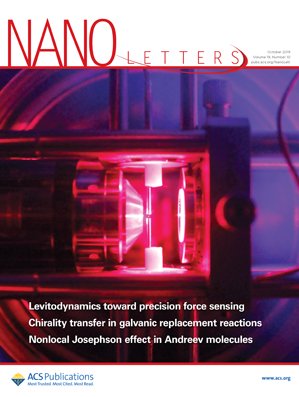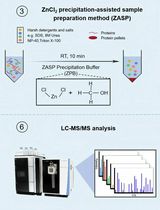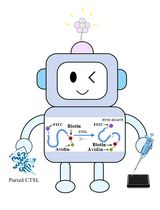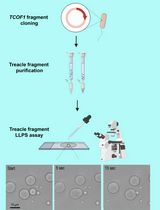- EN - English
- CN - 中文
Production and Isolation of Magnetic Protein Crystals in HEK293T Cells
HEK293T细胞中磁性蛋白晶体的生产与分离
发布: 2020年07月20日第10卷第14期 DOI: 10.21769/BioProtoc.3684 浏览次数: 4103
评审: Samantha E. R. DundonShalini Low-NamGundeep Kaur
Abstract
Advances in protein engineering have enabled the production of self-assembled protein crystals within living cells. Our recent publication demonstrates the production of ftn-PAK4, which is a ferritin-containing crystal that can mineralize iron and become magnetic when isolated. We have developed an optimized protocol for the production and isolation of PAK4-based crystals. The crystals are first grown in low-passage HEK293T cells, released using a lysis buffer containing NP-40 and DNase, and collected under careful centrifugation conditions. Our protocol maximizes the purity and yield of crystals and is quick and straightforward.
Background
Recent works have reported the production and isolation of “in cellulo” crystals through the heterologous expression of proteins in living cells. These crystals have varied applications, such as cargo delivery (Ijiri et al., 2009) or x-ray structure determination (Baskaran and Ang, 2015). The properties of the crystals vary, but they are generally quite large relative to the cell, ranging from 1-2 μm up to hundreds of μm in size (Schönherr et al., 2015). In our recent work, we modified inka-PAK4 crystals to create ftn-PAK4, which is a ferritin-containing crystal that can mineralize enough iron to be attracted to a nearby permanent magnet (Li et al., 2019).
The production and isolation of intact protein crystals poses several unique experimental challenges. Because the crystals are so large, purification methods such as gel electrophoresis cannot be used. Likewise, because the crystals are protein-based, harsher lysis conditions such as SDS will disassemble the crystals. However, clean suspensions can be critical for downstream applications. For example, excessive debris in an inka-PAK4 suspension can trap auto-oxidized iron and stick to crystals, generating spurious magnetic attraction results.
Here, we present a protocol for the production, isolation, and iron loading of ftn-PAK4 and inka-PAK4 crystals. It is possible to achieve results using only deionized water as the lysis buffer, but we present several optimizations that significantly improve crystal yield and minimize unwanted debris. These considerations should inform future work on other protein crystals, both for their production and isolation as well as their functional applications.
Materials and Reagents
- Pipettes and Pipette Tips
- 1.5 ml Eppendorf centrifuge tubes
- Glass slides
- 6 Well Tissue Culture Plate, Tissue Culture Treated, Flat Bottom (Fablab, catalog number: FL7105 )
- HEK 293T cells (< 10 passages) (ATCC, catalog number: CRL-3216 )
- DMEM High Glucose without Sodium Pyruvate (Gibco, catalog number: 11965092 )
- Penicillin/Streptomycin (Gibco, catalog number: 15140122 )
- Heat Inactivated Fetal Bovine Serum (Gibco, catalog number: 10438034 )
- Lipofectamine 2000 (Invitrogen, catalog number: 11668030 )
- Opti-MEM Reduced Serum Medium (Gibco, catalog number: 31985070 )
- GFP-PAK4, ftn-PAK4, and inka-PAK4 plasmids
- HEPES Buffer, 1 M, pH 7.2-7.5 (Gibco, catalog number: 15630130 )
- NP-40 (Sigma, catalog number: I8896 , also known as Igepal CA-630)
- Deoxyribonuclease I (DNase) (Worthington, catalog number: LS002007 )
- Earle’s Balanced Salt Solution (EBSS) (Life Technologies, catalog number: 14155-063 )
- Ferrous Ammonium Sulfate Hexahydrate (FAS) (Sigma-Aldritch, catalog number: FX0245 )
- D-Mannitol (Sigma-Aldrich, catalog number: M4125 )
- Concentrated Hydrochloric Acid (Fisher Scientific, catalog number: A144-500 )
- Potassium Ferrocyanide Trihydrate (MP Biomedicals, catalog number: 0 215256080 )
- Lysis buffer (see Recipes)
- DNase stock solution (see Recipes)
- Iron loading stock solution (see Recipes)
- Prussian Blue stain (see Recipes)
Equipment
- Centrifuge (Eppendorf, model: 5804 )
- Rocker (VWR Scientific Rocking Platform, Model 100)
- Microscope with Brightfield and Fluorescence Imaging (Leica, model: DMI 6000B )
Procedure
文章信息
版权信息
© 2020 The Authors; exclusive licensee Bio-protocol LLC.
如何引用
Li, T. L. and Cui, B. (2020). Production and Isolation of Magnetic Protein Crystals in HEK293T Cells. Bio-protocol 10(14): e3684. DOI: 10.21769/BioProtoc.3684.
分类
生物物理学 > 生物工程 > 蛋白封装
生物化学 > 蛋白质 > 分离和纯化
您对这篇实验方法有问题吗?
在此处发布您的问题,我们将邀请本文作者来回答。同时,我们会将您的问题发布到Bio-protocol Exchange,以便寻求社区成员的帮助。
提问指南
+ 问题描述
写下详细的问题描述,包括所有有助于他人回答您问题的信息(例如实验过程、条件和相关图像等)。
Share
Bluesky
X
Copy link













